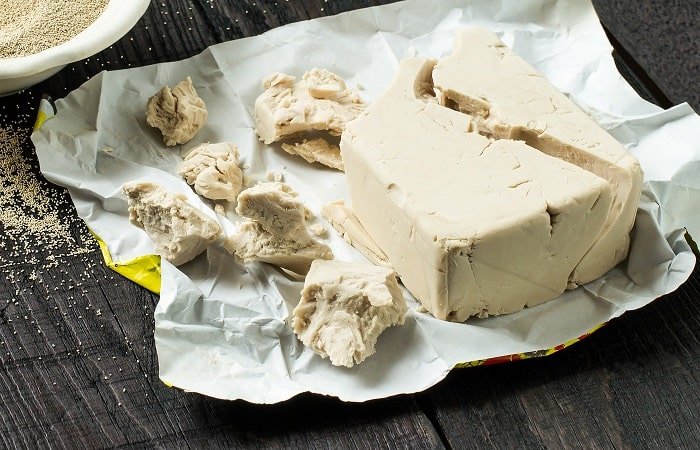Last Updated on January 6, 2023
If you’re a bread lover, you’ll know that yeast is a key ingredient in many types of bread. Yeast allows the bread to rise which in return helps give it its fluffy texture. If you are planning on making your own bread, you may wonder: how much yeast is in a packet?
For thousands of years, bakers have been using yeast while making bread. You must get the right amount of yeast for the bread recipe you are making. Yeast plays a vital role in achieving the proper texture in bread.
How Much Yeast Is In A Packet: How Yeast Works
You may not know this, but the yeast you use to make bread is actually live. It is a single-cell organism that not only allows the bread to rise but also helps give it flavor and texture. In addition, it helps strengthen the proteins in bread.
When looking at bread recipes, you’ll notice that many of them will say to add warm water to the yeast. When warm water is added to yeast it reactivates it, allowing it to do its wonders in the bread-making process.
Yeast is the ingredient in bread that allows it to rise. When yeast is added to bread dough, it breaks down large starch molecules into simple sugars. When this happens, carbon dioxide and ethyl alcohol are created, which creates air bubbles in the dough which leads it to rise.
Kneading and rising are important steps when using yeast in dough. Kneading allows the gluten to develop and rising allows the yeast to do its magic. Both steps are vital to a chewy, airy bread.
How Much Yeast is in a Packet?
When you buy yeast, it is generally sold in a packet. It is common for three packets to be sold together. Each packet of yeast contains ¼ ounce, which is the equivalent of seven grams or 2 ¼ teaspoons.
Though it varies by recipe, most bread will call for one packet, or slightly less than that, of yeast. You can also buy yeast in jars or bags, which can be great if you do a lot of baking. However, packets of yeast are often ideal, as you don’t have to worry about any moisture getting in, which will affect the yeast.
How Much Yeast Is In A Packet: Different Types
When it comes to baking bread, there are generally four different types of yeast that can be used. Active dry, instant, rapid rise, and fresh yeast are the types of yeast you will find for bread. Certain recipes may call for a specific type of yeast, while some can use any type.
Active dry and instant yeast are the most common types of yeast you can use. They are readily available in grocery stores and can be bought in packets.
Active dry yeast is made by the water being removed and it is turned into granules. Active dry yeast generally needs to be added to water before adding it to the dry ingredients.
Instant yeast is similar to active dry but is made up of a finer granule. It generally does not need to be added to water and can be added directly to the dry ingredients. There is a slightly different taste between active dry and instant yeast since they come from different strands, but they generally can be used interchangeably in bread recipes.
The rapid rise and fresh yeast are less commonly used in baking bread. Rapid-rise yeast is similar to instant yeast, however, it does come from a different strain that gives a stronger rise. Rapid-rise yeast is used for recipes that require just one quick rise, such as cinnamon rolls.
Fresh yeast can be tricky to find, but it can be a good option if you do a lot of baking. Also known as compressed or cake yeast, it can only be kept for about a week in the refrigerator. Unlike the other yeasts, it comes in a solid block form and needs to be crumbled and dissolved in water.
Storing Yeast
Though yeast does expire, it has a long shelf life. Yeast that is sold in packets, such as active dry or instant, can be stored at room temperature in a dry spot for 12 to 18 months, though it can be longer based on the expiration date printed on the package. Dry yeast is typically good two to four months past the best-by date, after that, it will likely not be good to use.
An opened packet of instant or active dry yeast can be stored in an airtight bag or container for three to four months in the refrigerator or the freezer for up to six months. If you want to extend the life of your unopened packets of yeast, you can store them in the freezer for several years.
To test if your yeast is still good, you can add one teaspoon of sugar to ¼ cup of water and stir it together with one packet of yeast in a measuring cup. If the yeast foams up to the half-cup mark after ten minutes, it is still good to use.
How Much is 1 Pack of Yeast?
Unfortunately, you can’t often buy individual packs of yeast on their own. The most common packets of yeast come in sets of 3. Depending on which brand you buy, and what type of yeast you buy, it can be relatively inexpensive.
Let’s compare some of the most popular brands and their prices:
- If you’re looking for instant yeast, Great Value (Walmart’s brand) has a set of 3 packets for just $0.86, meaning they’re just over $0.28 each.
- However, the more well-known brand, Fleischmann’s instant yeast is $1.72 for 3 packets, meaning they’re just over $0.57 each.
- And if we look at active dry yeast, Great Value has a set of 3 packets for just $0.86m meaning again, that they’re just over $0.28 each.
- And again, Fleischmann’s active dry yeast is $1.72 for 3 packets, making them just over $0.57 each.
- Great Value is the perfect option if you’re looking to bake bread on a budget.
What Can I Make With An Open Yeast Packet?
You’ve opened a packet of yeast and you haven’t quite used it all. Now you can either choose to store any leftover yeast in an airtight container or bag, or you can use it up instantly by making something else. There are many baked goods you can make with yeast, and it doesn’t just have to be plain loaves of bread. Here are some of my favorite baked goods to make using leftover yeast.
- Beignets. For beignets, the only ingredients you need are yeast, bread flour, sugar, milk, egg, and butter; most of which you’ll likely already have in your pantry. They’re quick to make and absolutely delicious.
- Breadsticks. Just like the ones you get from Olive Garden! The only ingredients you’ll need are yeast, flour, sugar, salt, milk, water, butter, and egg.
- Pizza dough. Pizza dough is one of the easiest ways to use up any leftover yeast and you can use whichever toppings you have available in the fridge! For pizza dough, you’ll only need yeast, sugar, salt, flour, water, and oil.
- Cheese and tomato focaccia. One of my all-time favorite bread. This one requires a few more ingredients but it’s worth the additional effort. You’ll need yeast, flour, sugar, salt, water, olive oil, tomatoes, cheese, garlic, and Italian seasoning.
- Pretzels. Pretzels are the perfect snack and to create them, you’ll need yeast, sugar, flour, salt, warm water, and an egg.
This list is by no means extensive and there’s a huge variety of other baked goods you can make with your open yeast packet. I’d love to know your favorites.
How Long Does an Open Pack of Yeast Last?
Once a packet of yeast has been opened, it reduces the shelf life significantly. Whereas usually, unopened yeast lasts anywhere from 18 months to 24 months, opened yeast will only last around 4-6 months. And even then, it must be stored correctly. It should be stored in an airtight container and should now be kept in the refrigerator, for best results.
Is a Package of Yeast Supposed to be Hard?
Absolutely not. While the packet of yeast will feel hard, once it’s been opened the yeast inside should be soft and crumbly in texture. It should also become foamy and frothy after around 10 minutes in water. If this is not the case for your yeast, it may be best to return it and start over with a new packet of yeast.
Using Yeast
Though yeast can be intimidating to use, many great bread recipes are simple to make. Yeast can be complicated, but as long as you follow all the directions of the recipe, you will have a loaf of delicious bread.
Since most recipes require the amount of yeast found in a packet, it makes it simple to use. Active dry and instant yeast will be your go-to yeasts when making bread, as they are accessible, easy to use, and generally interchangeable.
Active dry and instant yeast both come in packets that contain ¼ ounce, so you can use either one in most recipes. Most grocery stores will sell the yeast in packets of three. These packets are convenient to use and easy to store.
Please comment if you have any questions about how much yeast is in a packet or anything else regarding using yeast.

Karen is a passionate pastry chef who loves to create delicious baked goods. She has been in the culinary arts for over 10 years, honing her skills and perfecting her craft. Karen is known for her creativity and attention to detail, creating unique desserts that bring a smile to everyone’s face. She is always looking for ways to challenge herself and come up with new recipes that are both tasty and visually appealing. Karen loves to experiment with different flavors and textures, and she is committed to providing the highest quality of products to her customers.



